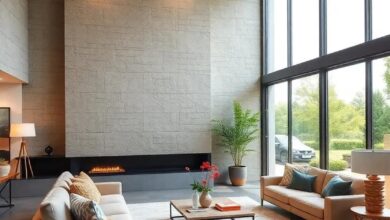Embracing Simplicity: Design Tips for a Small Living Room with Minimalist Textures
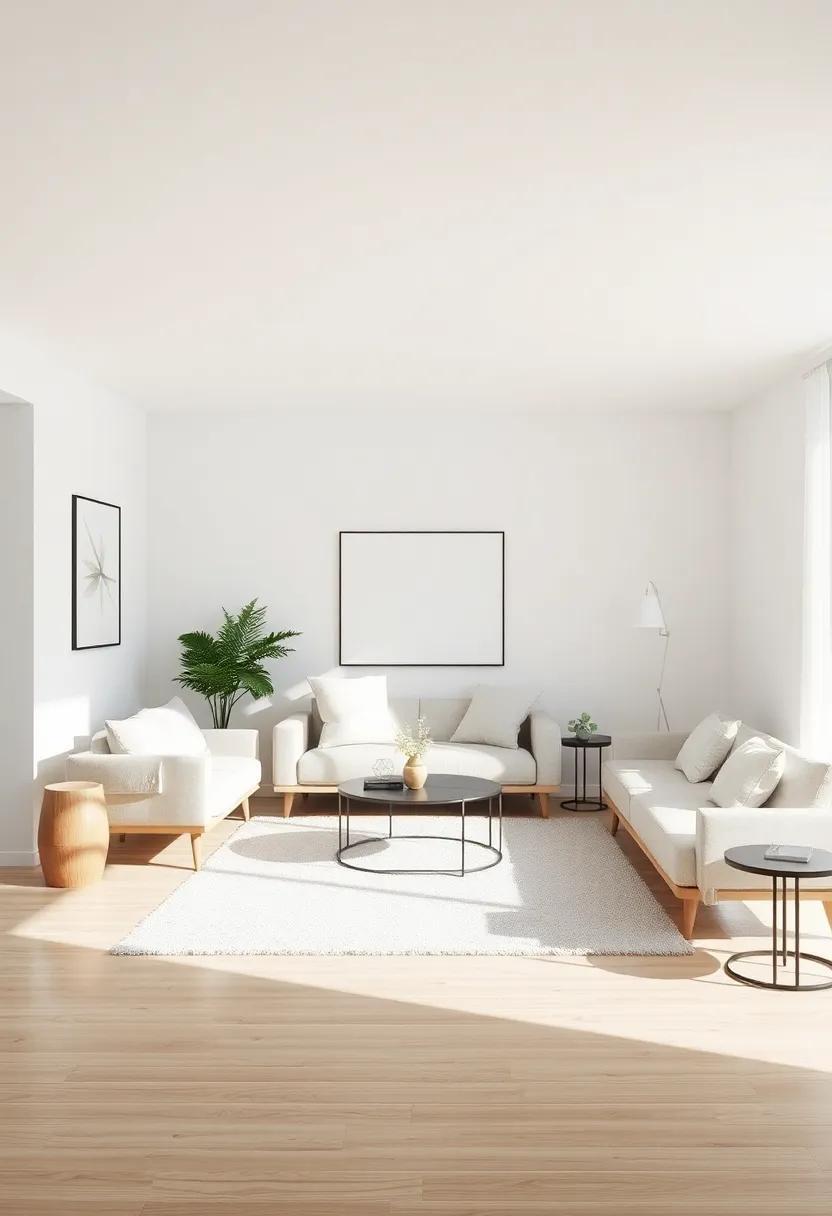
In today’s fast-paced world,the allure of simplicity stands as a beacon of tranquility,especially in the intimate setting of a small living room. While it may seem challenging to design a space that feels both spacious and inviting, embracing a minimalist approach can transform your nook into a serene sanctuary. By focusing on the interplay of textures,colors,and essential elements,you can cultivate an environment that balances functionality with aesthetic appeal. This article delves into effective design tips that celebrate the beauty of simplicity, helping you create a small living room that not only maximizes space but also embodies a calming atmosphere. Whether you’re a seasoned decorator or a novice looking to rethink your space,thes insights will guide you in harmonizing your surroundings with the effortless elegance of minimalist design.
Embracing Natural Light to Enhance Small Living Room Spaces
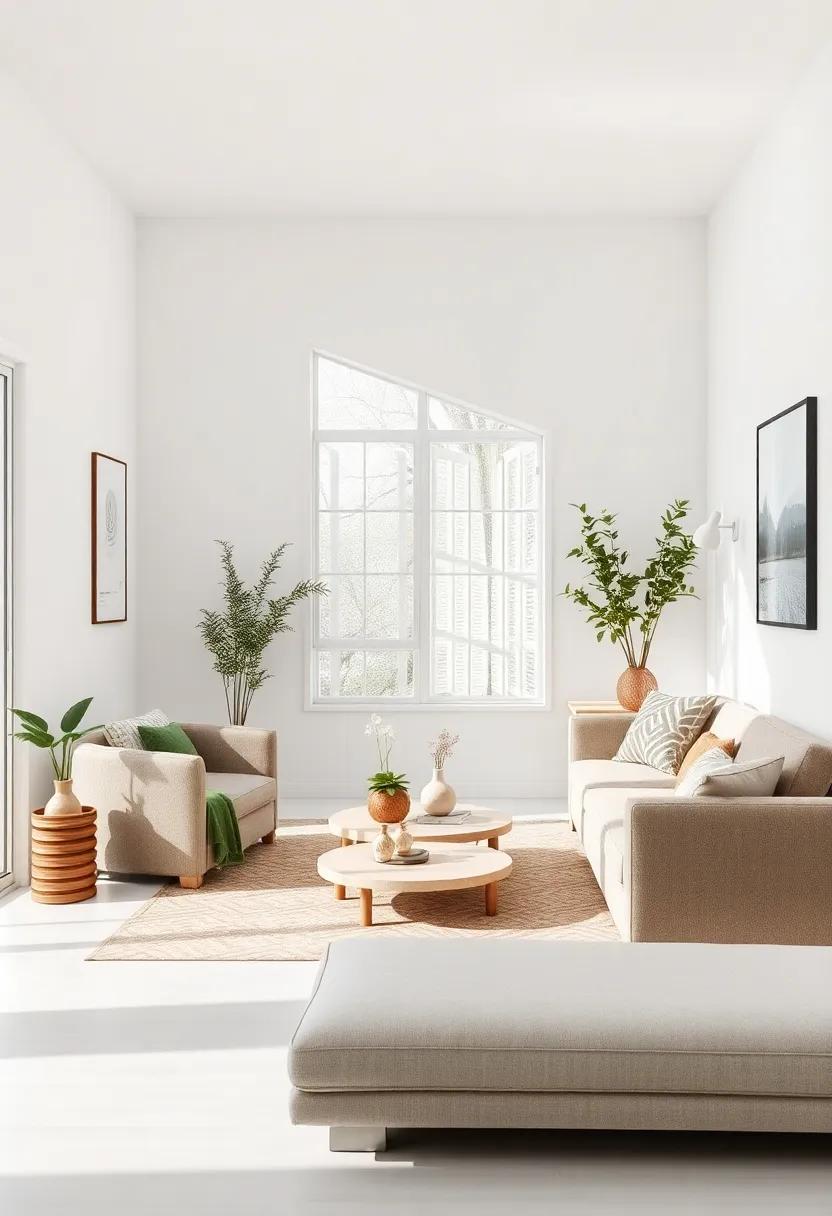
Utilizing natural light can transform a small living room into a bright and inviting atmosphere.Large windows or strategically placed mirrors can amplify sunlight, making the space feel larger and more open. Light-colored walls work harmoniously with this light to reflect brightness throughout the room. Additionally, consider using sheer window treatments that allow sunlight to filter in while maintaining a sense of privacy. This not only enhances the ambiance but can also highlight the minimalist textures you choose for your decor.
Incorporating light wood or subtle metallic finishes can create an elegant balance to your minimalist design. To further promote a sense of spaciousness, opt for furniture that sits low to the ground, allowing for uninterrupted sightlines and a more airy feel. Here are some tips to embrace natural light effectively:
- Use reflective surfaces like glass or polished metal.
- Choose soft, neutral palettes for furniture and decor.
- Incorporate greenery,which thrives in well-lit areas.
- Limit heavy draperies to maintain an open vibe.
| Aspect | Tip |
|---|---|
| Wall Color | Use light hues to reflect natural light. |
| Furniture | Select pieces with a minimalistic design. |
| Accessories | Incorporate items that are functional yet aesthetically pleasing. |
For more inspiration on using light in interior design, visit Architectural Digest.
Creating a Harmonious Color Palette for Minimalist Interiors
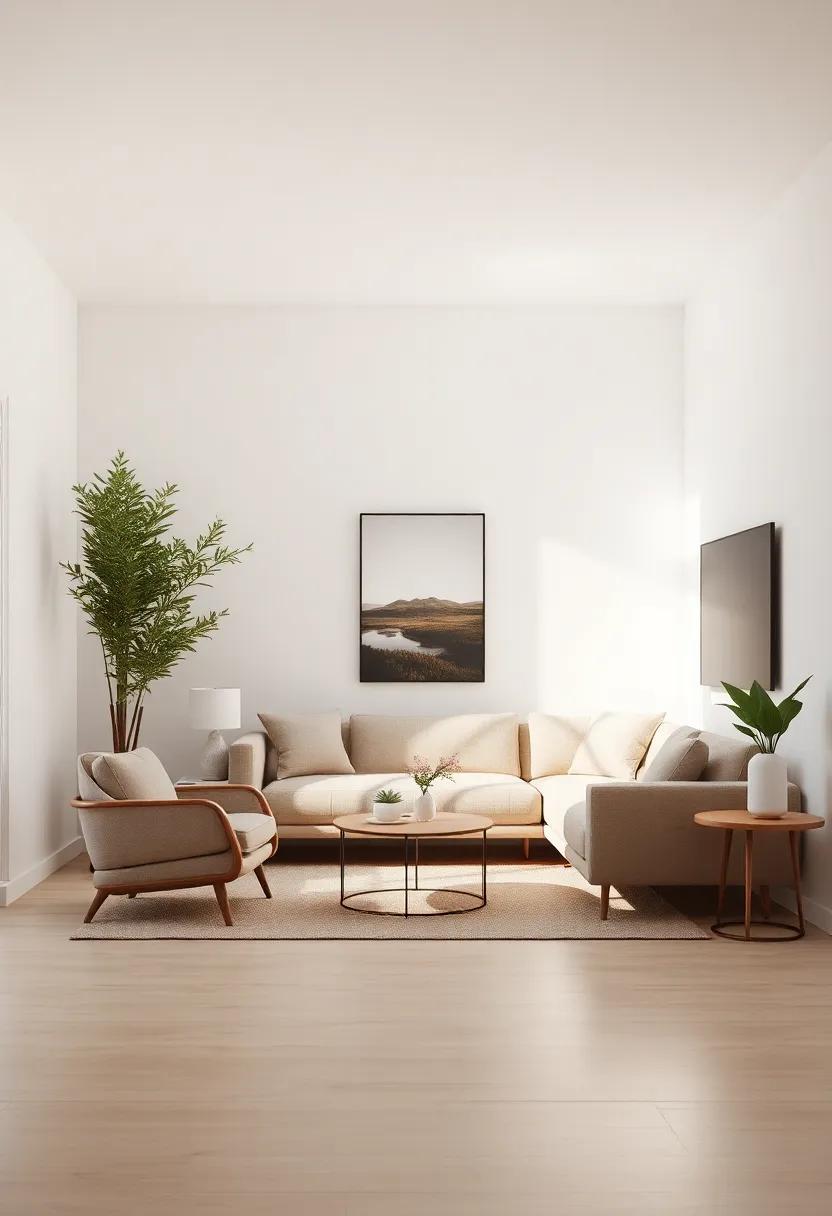
Creating a color palette for minimalist interiors is an art that hinges on thoughtful selections and harmonious contrasts.The aim is to enhance the sense of space while maintaining a tranquil atmosphere. Start by choosing a base color — this will act as the foundation for your palette. Consider soft whites, muted greys, or gentle earth tones. From there, you can add accent colors, which could be deeper shades of the same family or complementary hues that offer a pop without overwhelming the simplicity of the space. Use materials such as wood, stone, or fabric in these accent colors to maintain the cohesive vibe of minimalism.
When selecting your colors,it can be helpful to visualize their impact within various light conditions,as natural and artificial lighting will dramatically alter their appearance. Explore the use of monochromatic schemes, where different shades of a single color are layered to create depth while keeping things visually clean.Incorporating textured elements—like a woven throw or a sleek ceramic vessel—can elevate the overall aesthetic,making the space feel warm and inviting without cluttering it visually. For further inspiration and detailed examples, check out Pantone for color trends that can guide you in achieving the perfect minimalist palette.
Selecting Furniture with Clean lines to Maximize Space
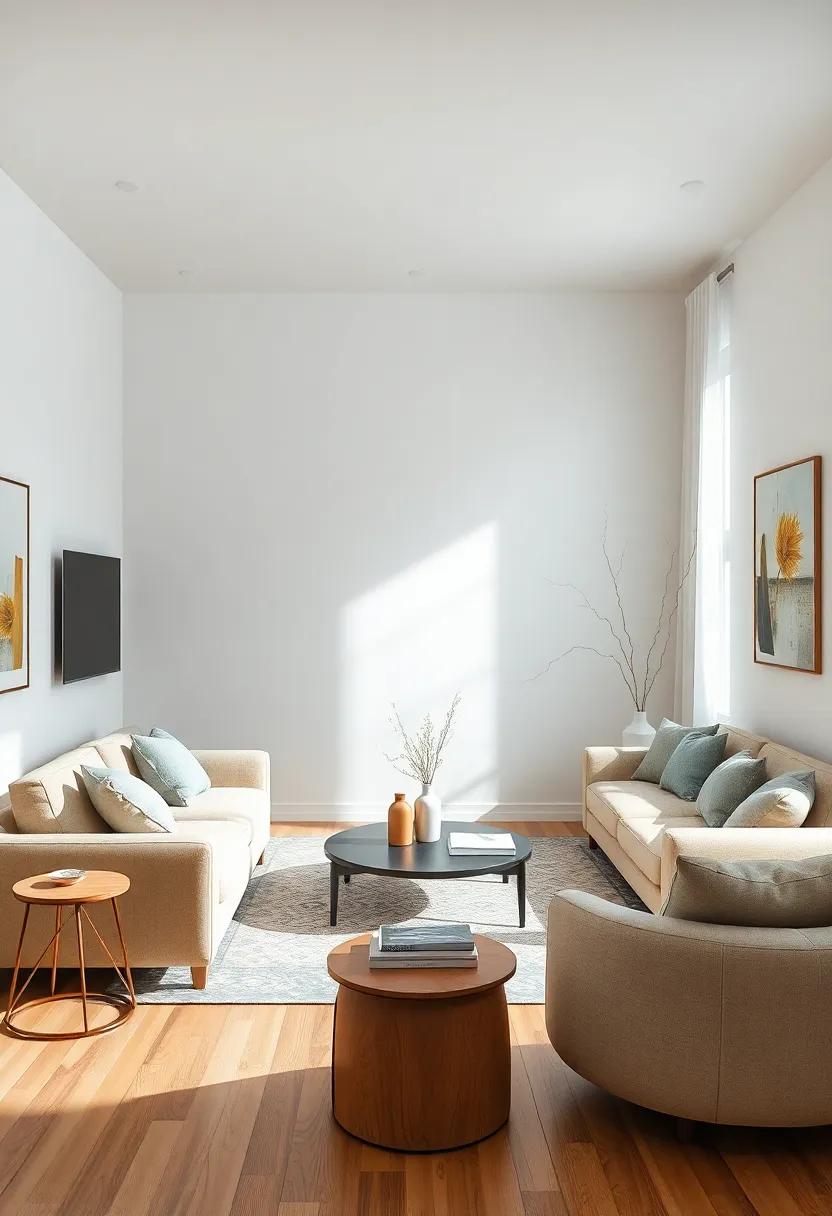
When designing a small living room, opting for furniture pieces that feature clean lines can dramatically enhance the sense of space. Sleek sofas, minimalist coffee tables, and accent chairs with simple silhouettes eliminate visual clutter, allowing the area to feel more open and inviting.Look for furniture that prioritizes functionality without compromising aesthetics—items that can double as storage or have multifunctional purposes are ideal. This not only maximizes space but also encourages an uncluttered atmosphere that aligns perfectly with a minimalist design.
Consider incorporating a few key elements to further optimize your small living room. Choose a color palette that complements the clean lines of your furniture—neutral tones like whites, grays, and beiges work wonders in creating a cohesive look. Adding a glass coffee table or a furniture piece with exposed legs can enhance the feeling of spaciousness by allowing light to flow beneath. Additionally,integrating mirrors strategically can reflect light and create an illusion of depth,enhancing the overall aesthetic. For more inspiration on furniture selection, browse options at IKEA to find pieces that combine both style and practicality.
Incorporating Multi-functional Pieces for Practical Living
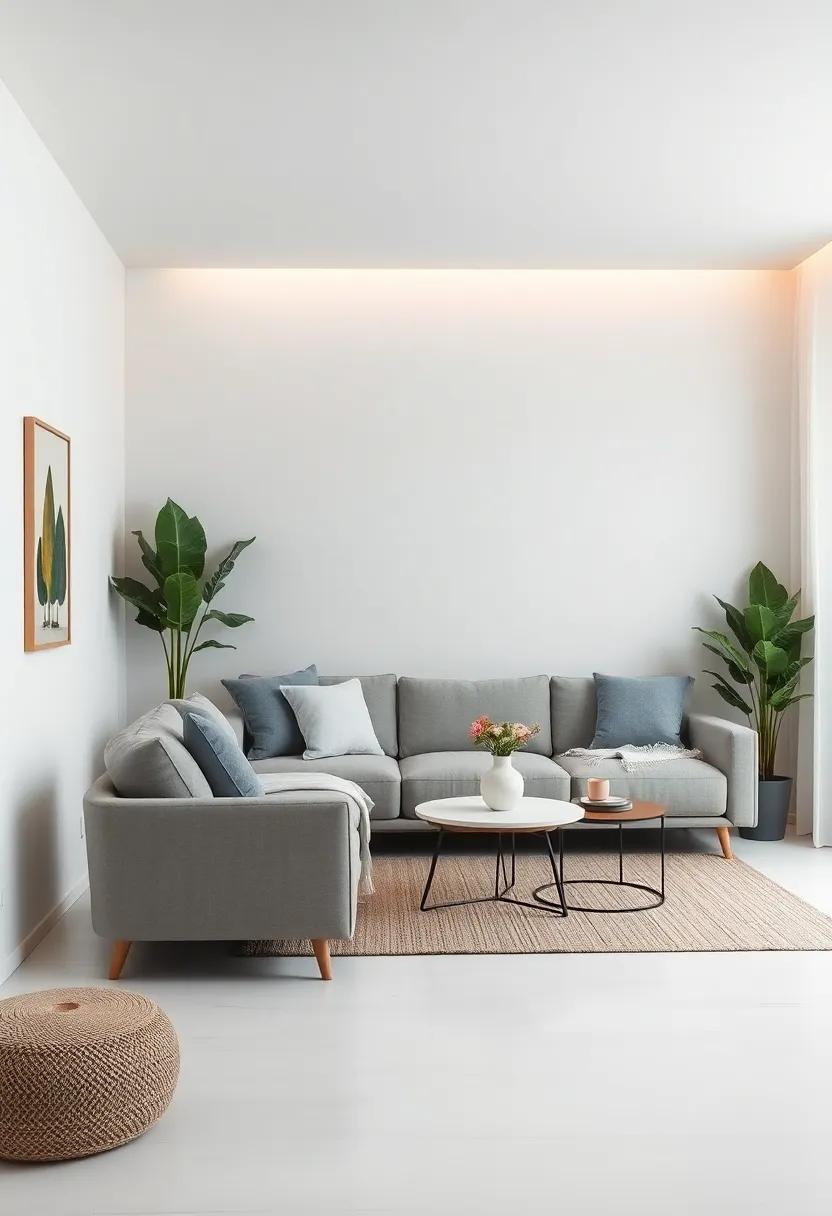
In smaller living spaces, the clever use of multi-functional pieces can transform a room’s utility while maintaining an air of simplicity. Consider investing in a sofa bed that seamlessly transitions from a comfortable seating area to a cozy sleeping space for guests. Another example is an ottoman with storage, which not only serves as a footrest but also provides hidden space for blankets, magazines, or seasonal decor. By selecting items that serve dual purposes,you can minimize clutter and enhance the room’s aesthetic appeal.
When choosing furniture, look for designs that prioritize both style and functionality. A folding dining table can be a game changer, allowing you to maximize floor space when not in use. Similarly,wall-mounted shelves can serve as decorative displays while keeping essential items organized and within reach. For inspiration on furniture configurations and layout ideas that promote practicality without sacrificing charm, check out Apartment Therapy. Embracing such elements will not only emphasize the minimalist textures of your living room but also create a harmonious environment that feels open and inviting.
Utilizing Vertical Space for Creative Storage Solutions
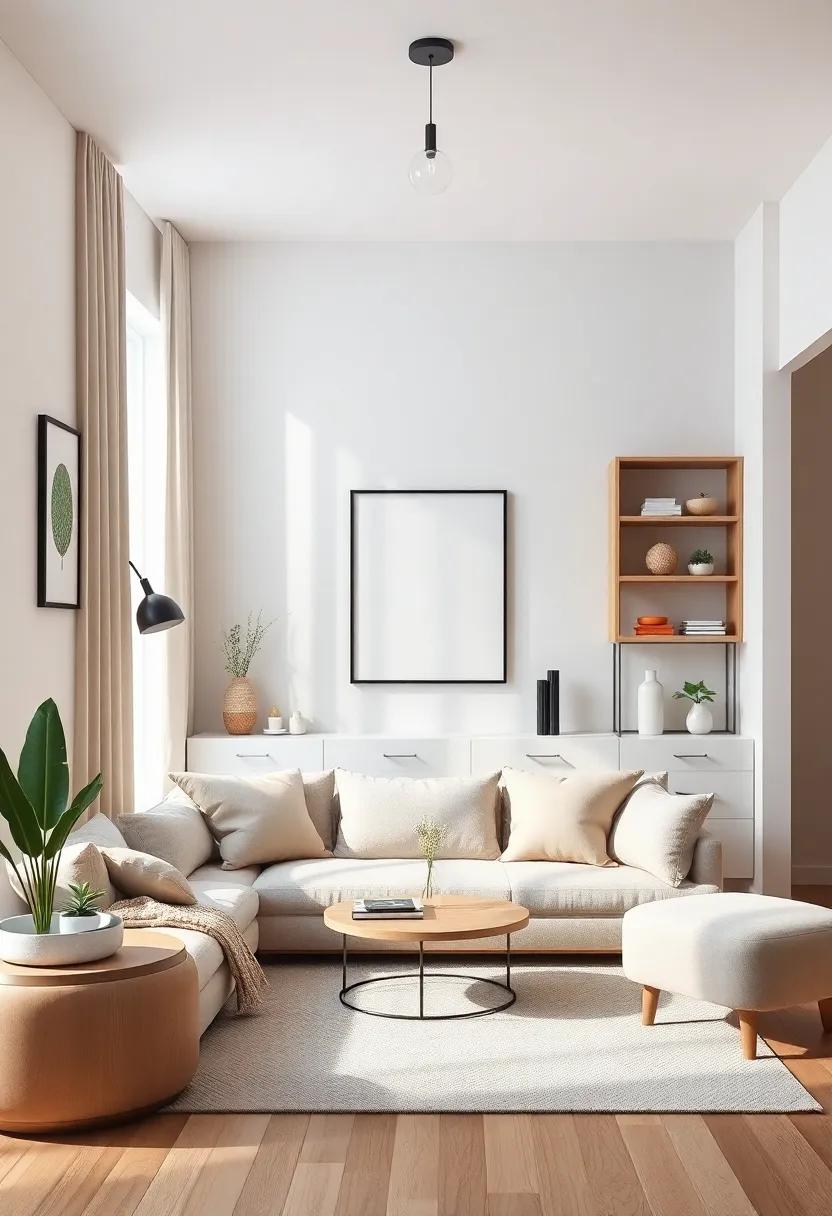
In small living rooms, utilizing vertical space is essential for maximizing storage while maintaining a clean, minimalist aesthetic. Consider installing wall-mounted shelves that can hold books, plants, or decorative items, freeing up precious floor space. Opt for floating shelves that create an airy feel, allowing light to pass through and giving the illusion of a more spacious room. Additionally, vertical cabinets can provide ample storage without taking up too much width. Incorporating tall bookcases can also draw the eye upward, creating an optical illusion of height, which is notably beneficial in snug areas.
Another effective strategy is to use multifunctional furniture that doubles as storage. Look for ottomans with hidden compartments or benches that can be used as both seating and storage. Hooks and pegboards mounted on walls can serve as a unique way to organize items such as bags, hats, or even kitchen utensils, inviting creativity into your living space. Utilize decorative bins or baskets on super high shelves as storage solutions that blend seamlessly into your design. For further innovative ideas,explore Apartment Therapy for tips tailored to small living spaces.
Textures that Speak: Choosing Fabrics for a Cozy Ambiance
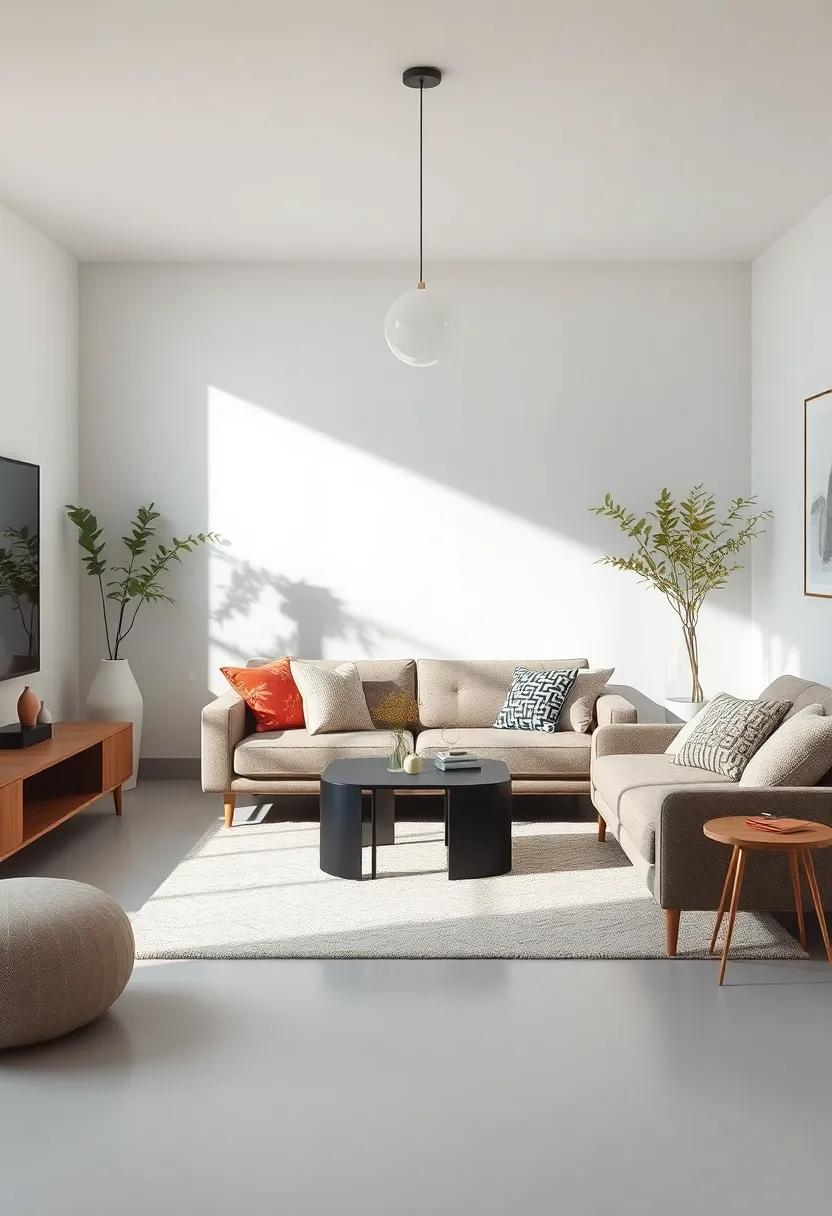
When curating textiles for a cozy atmosphere, the selection is crucial. Fabrics can evoke feelings of warmth or freshness, so consider layering various textures to create depth without clutter. Elements such as linen, wool, and cotton provide a tactile contrast while maintaining a minimalist vibe. With a focus on natural tones, these materials come together to form a harmonious environment where simplicity reigns. Incorporate these fabrics through items like throw blankets, cushions, or even a soft area rug to invite both comfort and style into your small living room.
Lighting plays a pivotal role in showcasing these textures. Soft lighting can highlight the intricacies of your fabric choices, adding to the overall ambiance. Accent pieces,like fabrics with varying degrees of sheen,can leverage natural light to enhance the cozy feel. A combination of matte and glossy finishes,as an example,can produce fascinating reflections and shadows,enriching your space. To maximize the cozy factor, consider creating a small table setting where these fabric choices are front and center, inviting conversation as well as aesthetic appreciation. For further inspiration, explore Apartment Therapy for diverse ideas on fabric and texture integration.
Curating a Balanced Layout for Open and inviting Areas
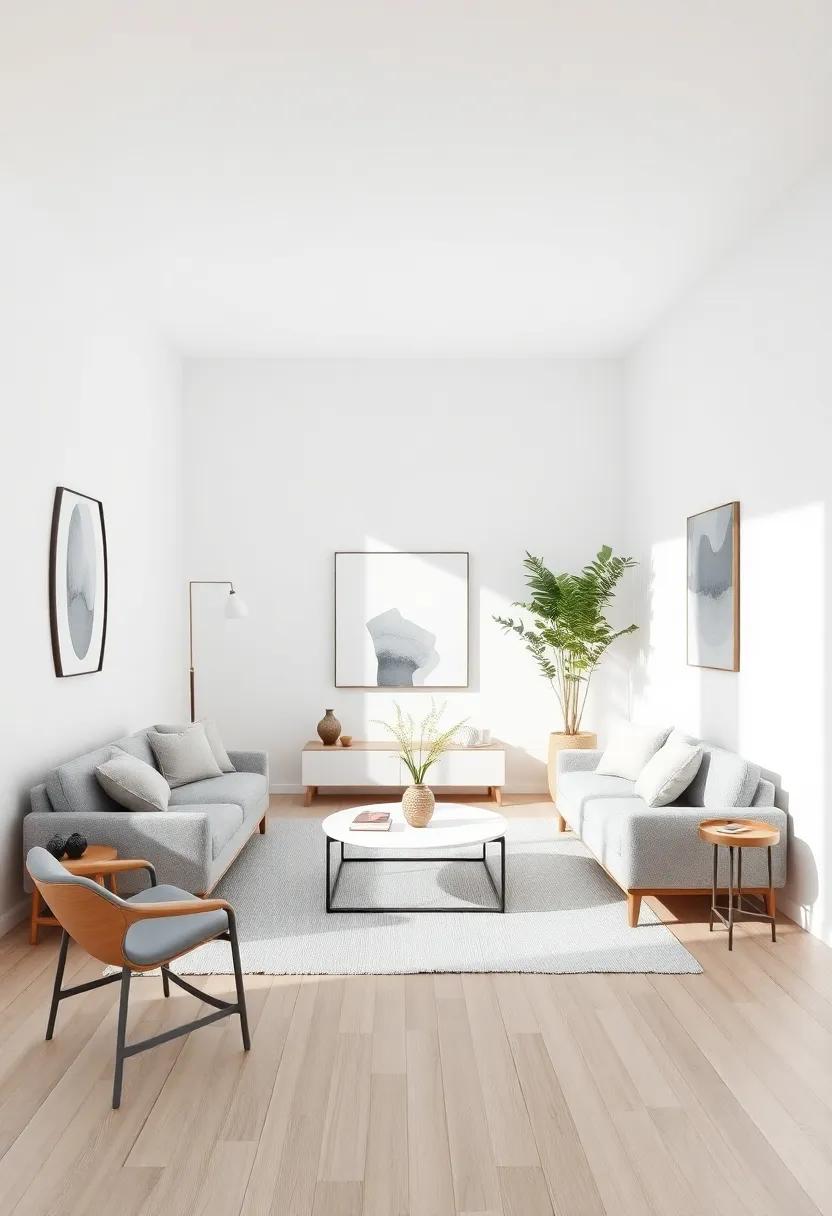
Creating an inviting atmosphere in your small living room is about achieving a harmonious balance between form and function. Opt for modular furniture that emphasizes versatility; sofas with clean lines or ottomans that double as storage can open up the space without sacrificing comfort. Incorporating natural elements further enhances the inviting feel. Consider elements such as indoor plants or wooden accents that bring warmth into your minimalist aesthetic, making the environment feel more cohesive and approachable.
When planning your layout, pay attention to the flow of movement to create a seamless experience for anyone entering. Start by arranging key furniture pieces in a way that encourages interaction and accessibility. Use area rugs to delineate spaces for different activities, whether reading, entertaining, or relaxation. Counterbalance heavier items with light textures—like sheer curtains or a soft blanket draped over a chair—adding layers that invite touch without overwhelming the senses. For further inspiration on minimalist design, visit Apartment Therapy.
Incorporating Statement Lighting without Compromising Space
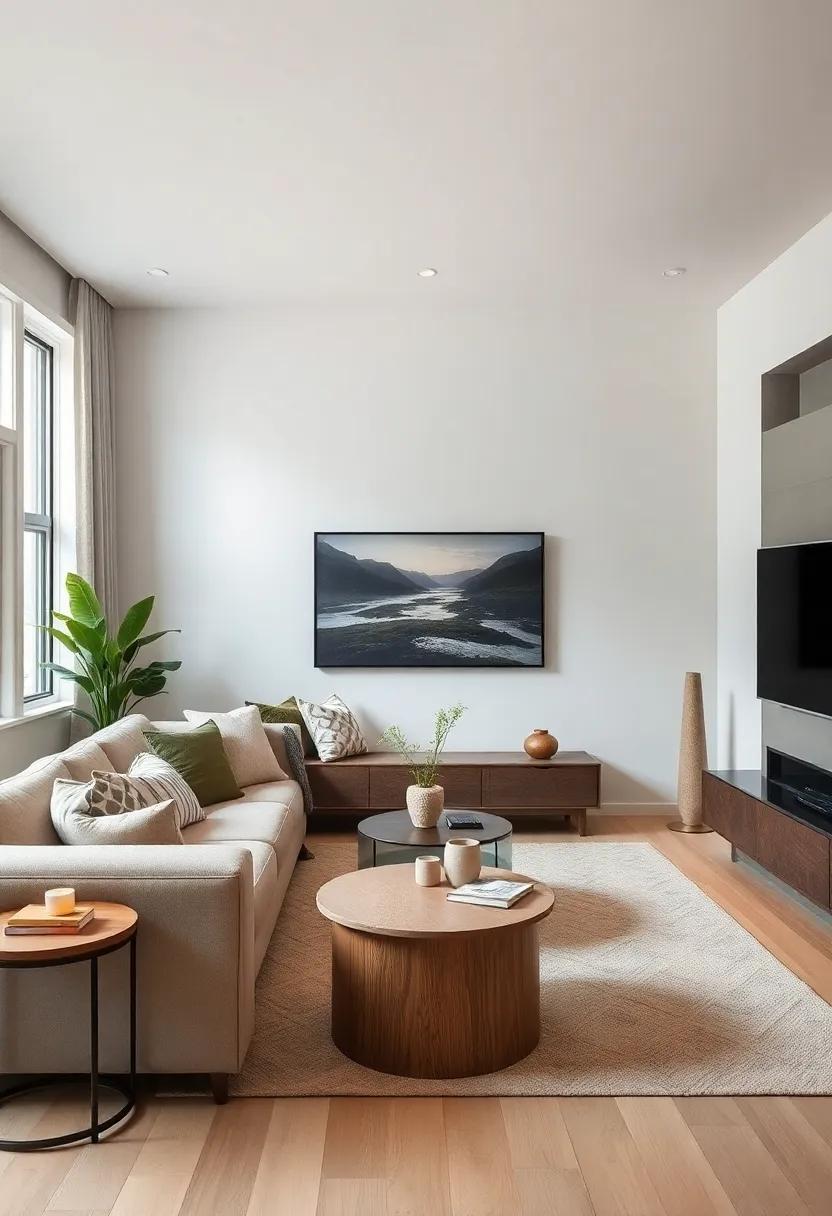
When choosing statement lighting for a small living room, consider options that draw the eye upwards, creating a sense of height and spaciousness.Oversized pendants or dramatic floor lamps can serve as focal points without taking up excessive visual or physical space. When selecting fixtures, opt for those incorporating translucent materials like glass or acrylic, as these allow light to flow freely through the space, enhancing the airy feel. Additionally, strategically placed lighting can help define distinct areas within your living room, ensuring the overall ambiance feels cohesive yet open.
The key to introducing bold lighting elements is to combine them with minimalist design principles.Choose fixtures that are not overly ornate but still maintain a unique silhouette. Complement these with a neutral color palette for your walls and furnishings to allow the lighting to shine without overwhelming the space. Incorporating reflective surfaces such as mirrors or metallic accents will also amplify the natural light and make your small living room feel more expansive. For an inspiring selection of statement lighting, visit Lamps Plus for a wide variety of options tailored to smaller spaces.
Artful Arrangements: Displaying Decor with Purpose
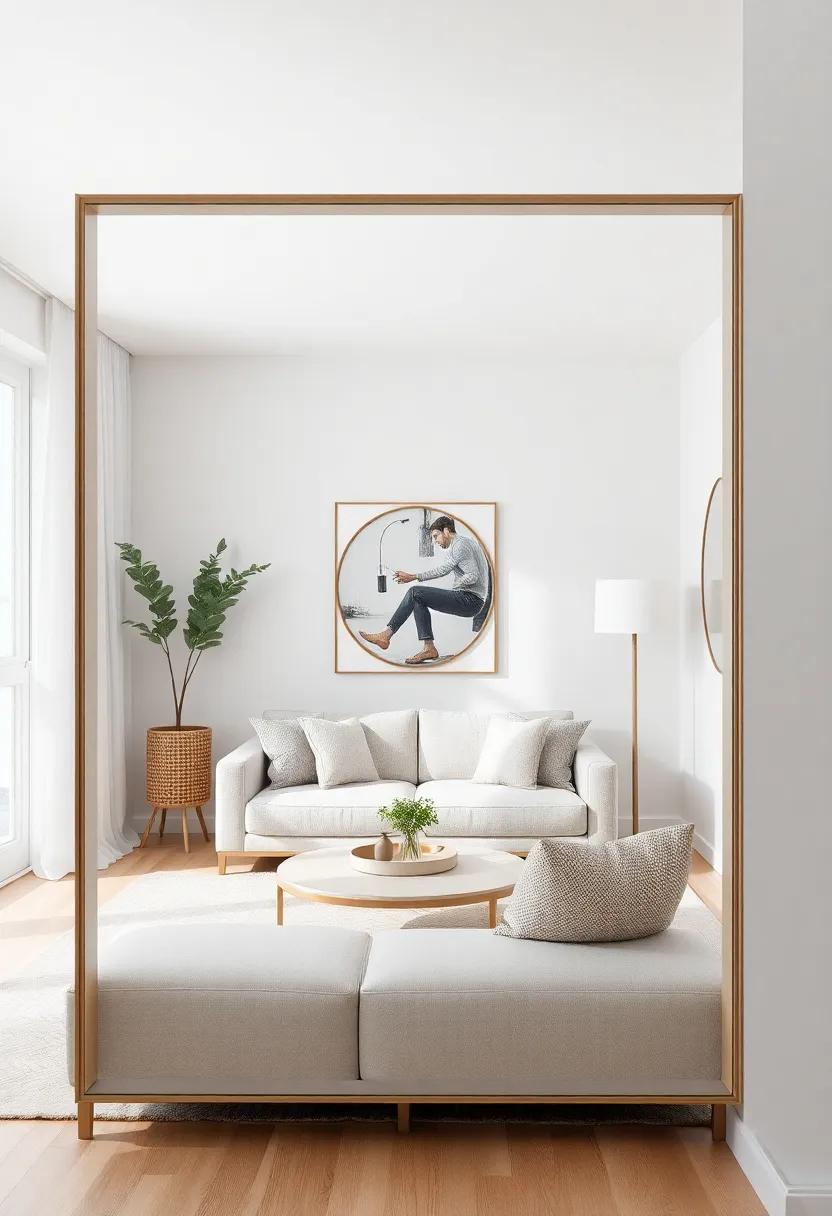
Transforming a small living room into a haven of minimalist elegance hinges on the thoughtful arrangement of decor. Opting for lightweight structures and integrated storage solutions not only maximizes your space but also keeps your surroundings visually appealing. Create a focal point using stacked books or a sculptural piece that draws the eye without overwhelming the area.When displaying items, consider the use of trays and plinths; these can help organize collections while maintaining a clean, uncluttered look. Remember,every piece in your living room should serve a purpose,enhancing both functionality and aesthetic while still allowing for that coveted sense of calm.
Color palettes play a crucial role in the art of arrangement, especially in small spaces. Sticking to a neutral foundation with occasional pops of color in your decor can keep the ambiance fresh and inviting. For example, display soft-hued cushions alongside a textured duvet on the couch – this not only adds comfort but also encourages a layered texture that draws people in. Moreover, hanging a single statement piece of art can act as a visual anchor, providing balance amidst the minimal clutter. Utilize vertical space by installing shelves to showcase curated decor items and plants, enhancing both height and visual depth. For more inspiration,explore the ideas on Apartment Therapy.
Layering Textures to Add Depth to a Simplistic Design
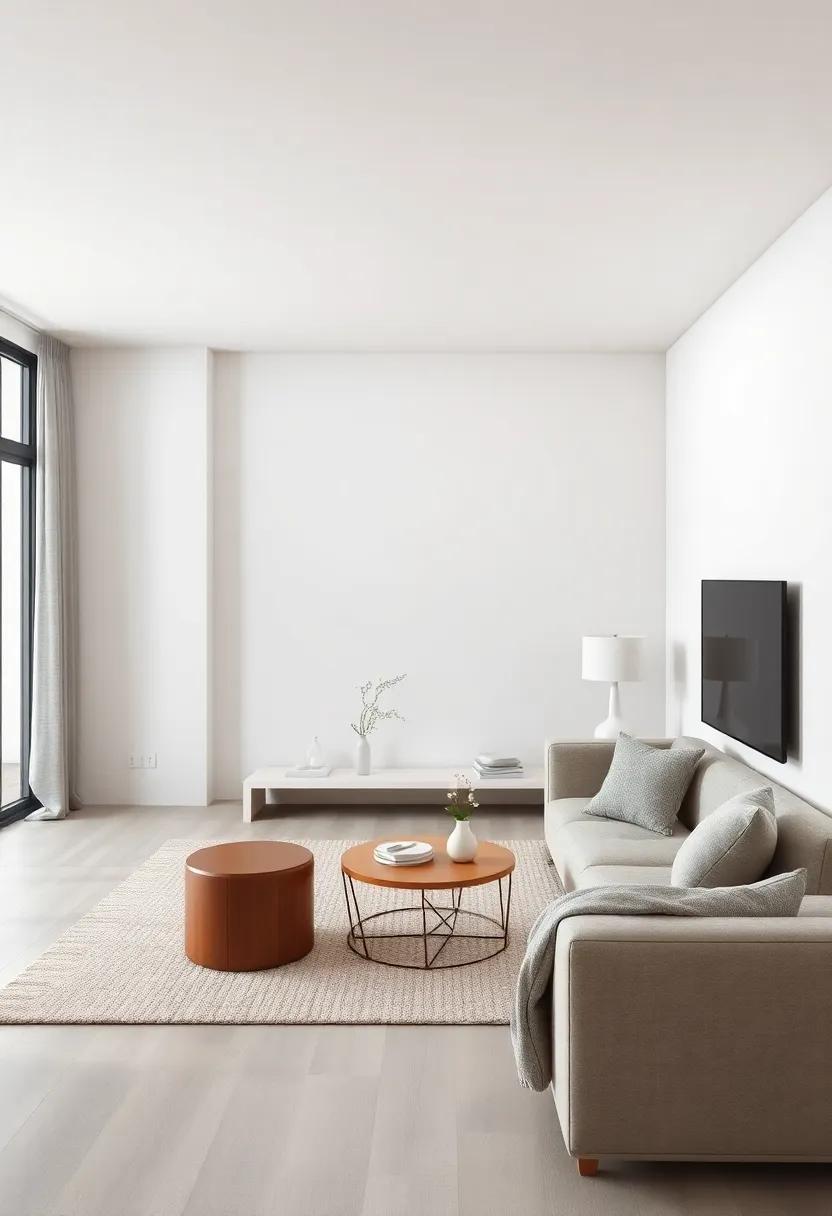
To create visual interest in a small living room designed with minimalism in mind, layering textures can breathe life into an or else flat aesthetic. By thoughtfully combining various materials,you can draw the eye and establish depth without the need for clutter. Consider these texture options:
- Soft textiles: Incorporate plush cushions and throws in different fabrics like cotton,wool,or velvet to invite comfort.
- Sleek metals: Add metallic accents through lamp stands or picture frames to introduce a subtle sheen.
- Natural elements: Use wood or stone pieces to create warmth and grounding in your space.
- Matte vs. glossy finishes: Play with contrasting finishes to enhance visual complexity while maintaining simplicity.
Integrating these textures effectively can create a cohesive yet dynamic environment. One effective strategy is to establish a color palette that allows these textures to complement one another. This will ensure that the various materials harmonize,creating a tranquil atmosphere. Consider a minimalist color scheme that emphasizes subtle differences in texture rather than competing colors. Here’s a simple table to help you visualize the concept:
| Texture | Suggested Color |
|---|---|
| Wool Throw | Soft Gray |
| Metallic Lamp | Brushed Gold |
| Wood Coffee table | Natural Oak |
| Canvas Wall Art | Muted Blue |
For further inspiration on incorporating textures without overwhelming your space, check out Apartment Therapy.
Finding the right area Rugs to Define Spaces Elegantly
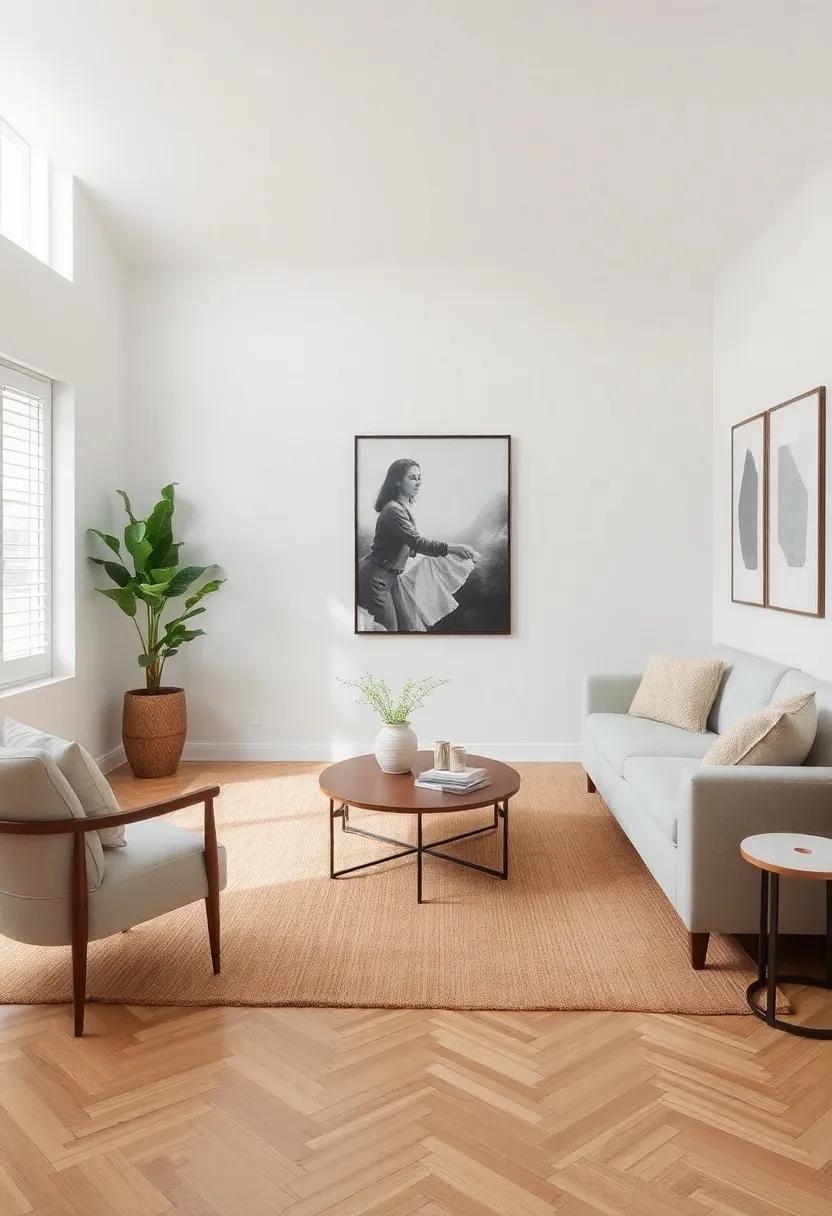
Choosing the right area rug can be transformative, particularly in a small living room where space is at a premium. A well-selected rug acts as an anchor for your furniture, helping to define areas and create a sense of flow. When selecting the perfect piece, consider the following factors:
- Size: Ensure that your rug is appropriately sized to fit the main seating area, allowing at least the front legs of your furniture to rest on it for cohesion.
- Color and Pattern: Opt for a subtle pattern or a solid color that complements the minimalist theme while adding dimension to the space.
- Material: Choose a durable yet soft material like jute or wool, as these textures provide comfort while maintaining a clean aesthetic.
Another aspect to consider is the placement of the rug, which can further enhance the elegance of your small living room. A rug positioned beneath a coffee table can help delineate the lounge area from the rest of the space, inviting a relaxed gathering atmosphere. Here’s a fast table summarizing optimal placements:
| Placement | functionality |
|---|---|
| Underfoot of Coffee Table | Defines the seating area |
| In Front of Sofa | Creates a warm welcome |
| Under Dining Table | Sets a cohesive dining space |
For more inspiration on selecting the right area rugs, visit Rug and Home.
Framing Views: Strategically Placing Mirrors for Illusion
Mirrors are not just decorative elements; they are powerful tools that can transform the perception of space in your living room. By strategically placing mirrors, you can create an illusion of depth and enhance natural light, making your small space appear larger and more inviting. Consider positioning a large mirror directly across from a window or a light source. This not only reflects light but also offers an appealing glimpse into an open atmosphere. Framing your views with elegant borders or minimalistic designs on mirrors can elevate the overall aesthetic while maintaining a clean look.
another effective approach is to use a series of smaller mirrors clustered together, forming a gallery wall that draws the eye upward and encourages exploration of the space. When placing these mirrors, think about the angles; placing them at varying heights adds visual interest and dynamic flow. To complement the simplicity of your design, choose mirrors that feature subtle textures or metallic finishes that align with your minimalist theme. For more inspiration on mirror placement and design, you can visit Architectural Digest.
Integrating Greenery for a Fresh Touch in Minimalism
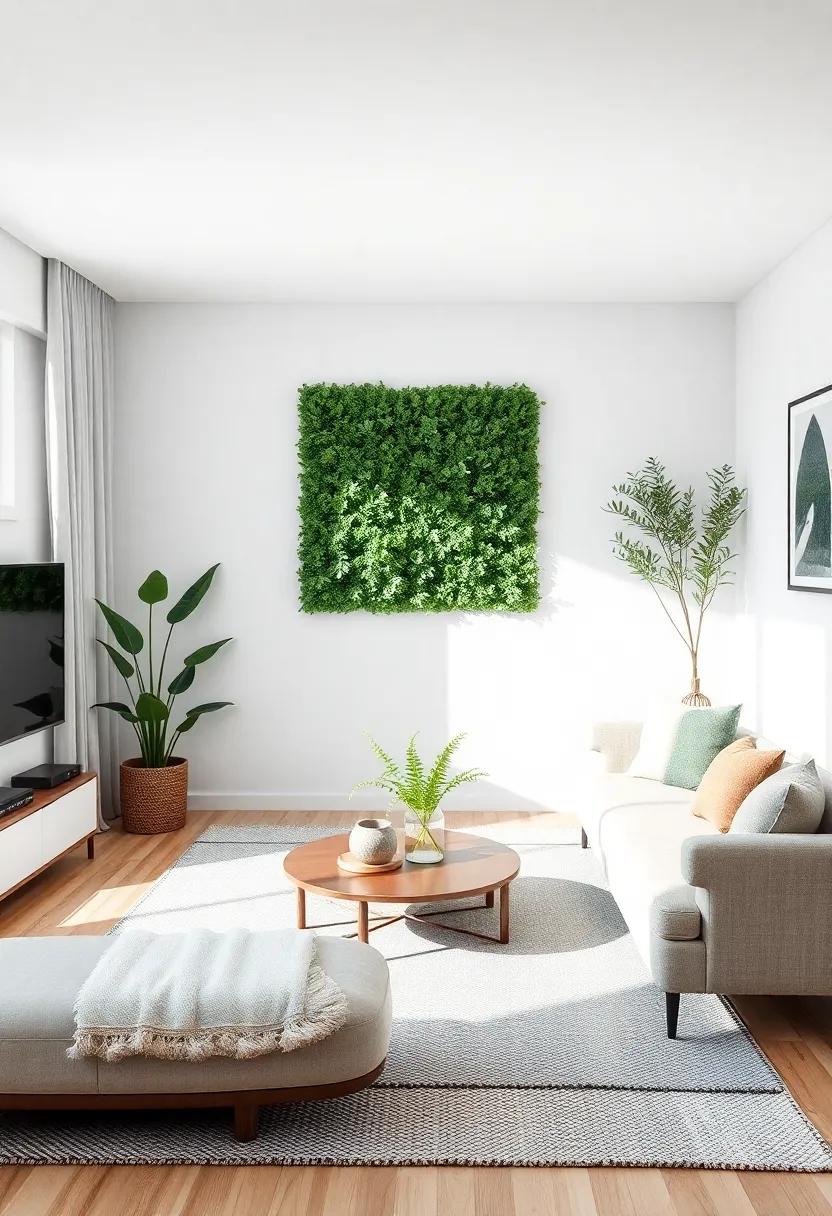
Integrating living plants into a minimalist space can transform the aesthetic,offering a vibrant contrast to clean lines and neutral palettes. Consider selecting a variety of plants to create an inviting focal point or soft accents throughout the room. small succulents or cacti can thrive in limited light while requiring minimal care, making them ideal for even the tiniest nooks.Alternatively, trailing vine species like pothos can add a dynamic element to wall shelves or hang from the ceiling, allowing nature to soften the starkness of minimalist design.
When choosing plant pots, look for those that complement your minimalist vision. Opt for ceramic, concrete, or glass containers in muted tones or simple shapes to maintain visual cohesion. To maximize space efficiency and enhance your small living area,create a green wall or vertical garden using a simple wooden shelf. arrange your plants in varying heights for an organic yet organized appearance. For additional inspiration, explore resources on Angi that highlight ideas for incorporating greenery into your home effortlessly.
Flow and Function: Crafting Walkways that Invite Movement
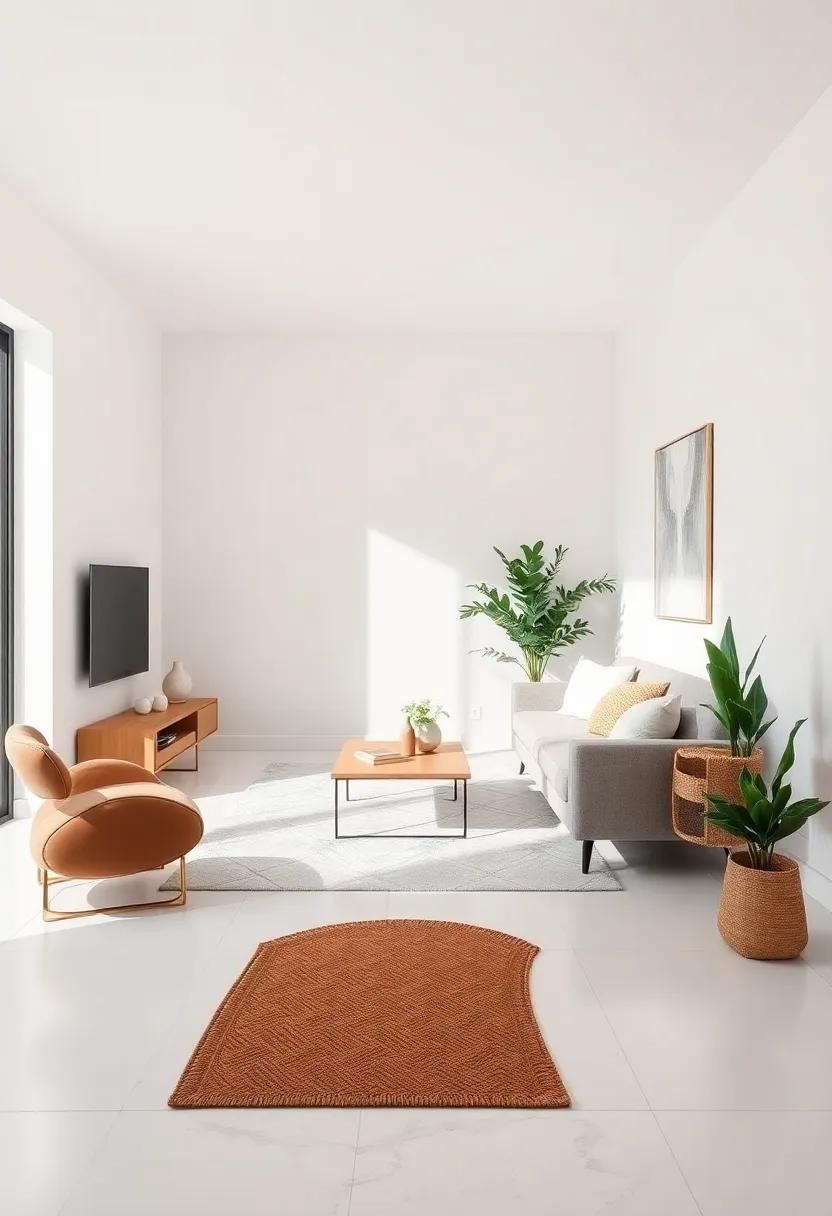
When designing a small living room, creating a seamless flow between spaces is crucial. Walkways should be carefully crafted to facilitate movement, allowing occupants to navigate effortlessly. Emphasizing a minimalist aesthetic, consider using aligned furniture arrangements and open pathways that encourage free movement throughout the room. A few strategic placements can enhance the spatial perception, making the area feel larger and more inviting. Elements such as low-profile sofas or floating shelves contribute to this effect, drawing the eye upward and maintaining an uncluttered floor space.
To further enhance the sense of flow, incorporating natural materials can add depth without overwhelming the senses. Choose items like light wood, soft textiles, and neutral color palettes to create a harmonic environment. Additionally,utilizing multi-functional furniture—such as ottomans that double as storage—can maximize efficiency while maintaining simplicity. The use of reflective surfaces, like mirrors, can also create an illusion of expanded space. For more insights on minimalist design principles, explore resources available at HouseBeautiful.com.
Personal Touches: Adding Character Without Clutter
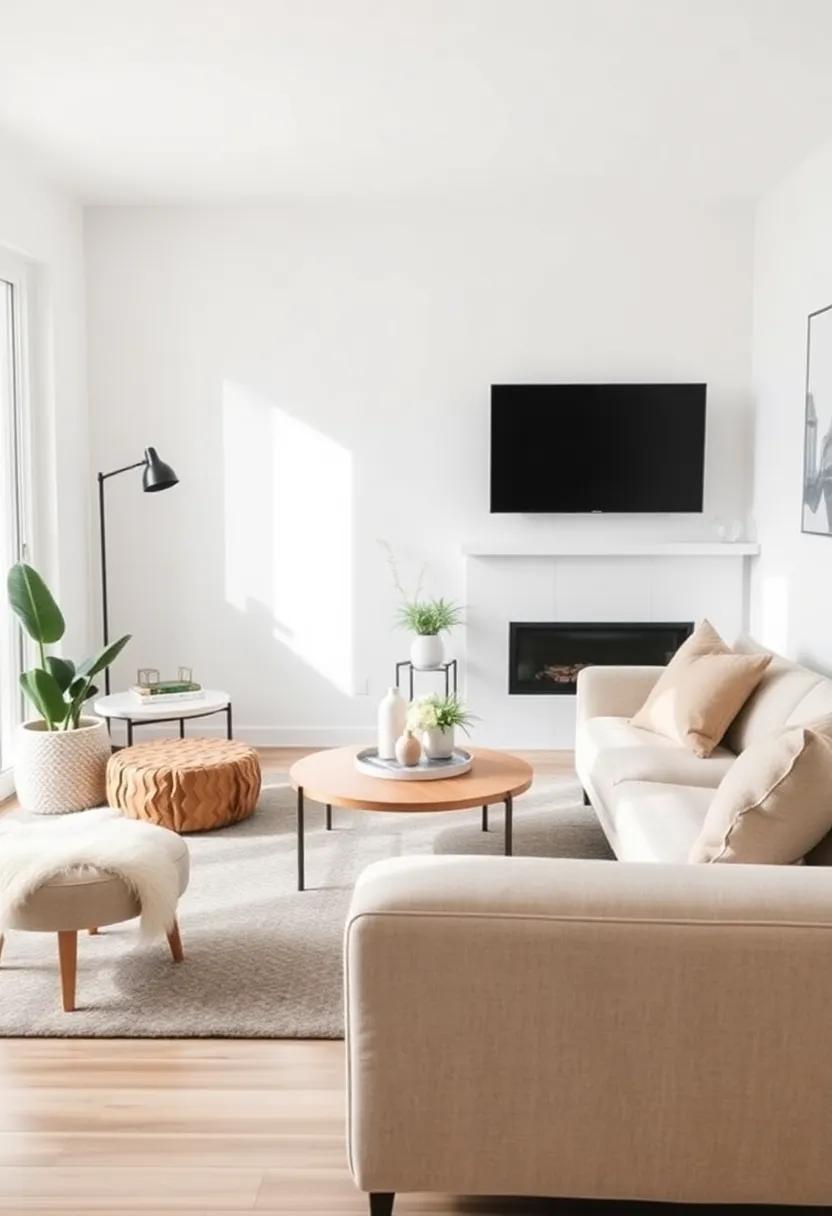
Creating a space that reflects your personality while maintaining a minimalist aesthetic can seem challenging, but it’s entirely achievable. To incorporate a personal touch without overwhelming your small living room, consider curated collections that tell your story. instead of scattering numerous trinkets throughout the space, select a few key items that resonate with you.For instance, a vibrant piece of art or an antique vase can serve as a focal point, adding character and intrigue. Use floating shelves for layered displays of your selected items, allowing for a visually appealing arrangement that enhances your living space without cluttering it.
Another effective method to add charm is through textiles that capture your essence. opt for throw pillows or a cozy blanket that showcases your favorite colors or patterns, strategically placed on a neutral sofa. Wall hangings made of natural materials or a simple gallery of black and white photographs can add warmth and depth. To create an air of harmonious balance, ensure that any decorative features complement the minimalist theme. Utilize a soft color palette and vary the textures so that the space feels inviting yet serene. Emphasizing these personal elements helps cultivate a uniquely ‘you’ space, drawing visitors in without overwhelming them.For more tips on minimalist living, explore Architectural Digest.
Selecting Minimalist Accessories that Elevate the Space
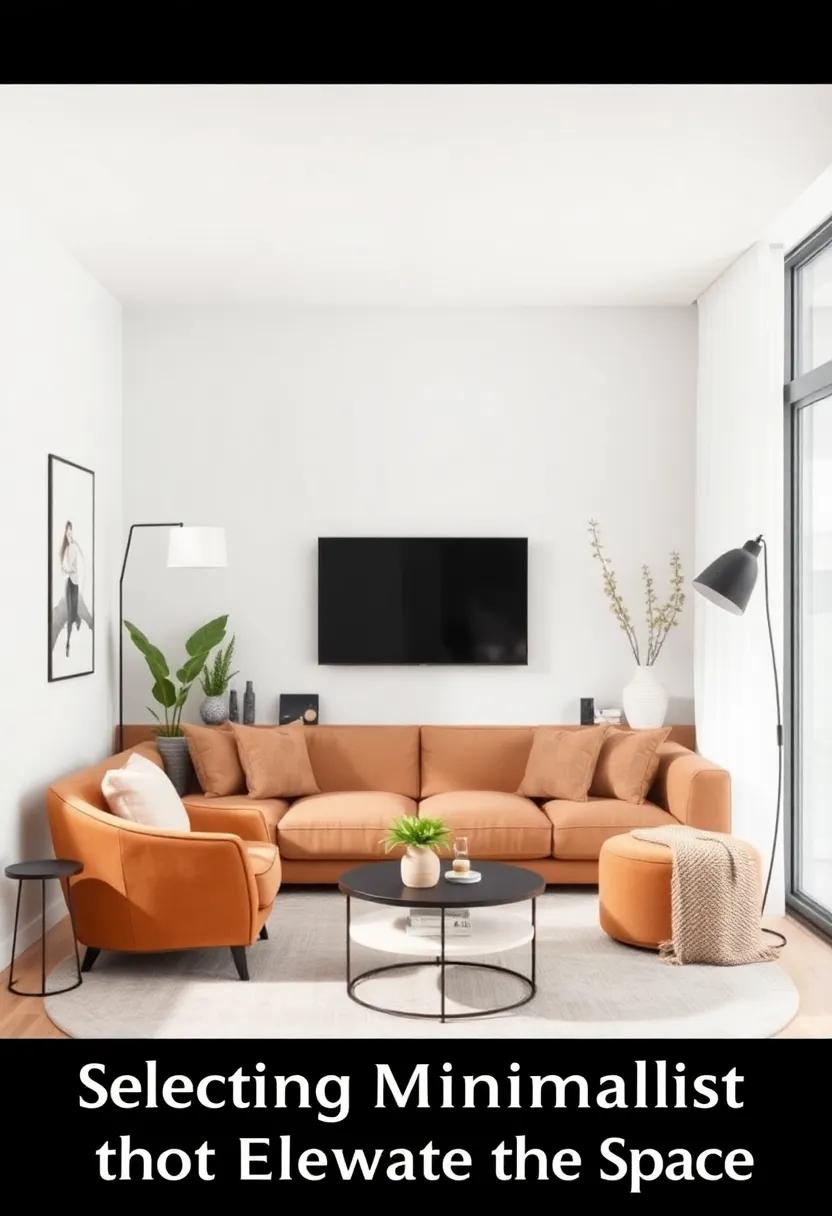
When it comes to accessorizing a minimalist living space, the key is to choose items that not only serve a purpose but also contribute to the overall aesthetic. Opt for timeless pieces that are functional yet visually appealing, ensuring they blend seamlessly with your existing decor.consider the following options for excellent accompaniment:
- Geometric vases: Simple shapes can add a touch of elegance without overwhelming the senses.
- Neutral-tone throws: These can provide warmth and texture, inviting comfort while still being understated.
- Artistic wall clocks: Look for designs that strike a balance between form and function, allowing for a elegant touch.
Moreover, lighting is crucial in a small room, and minimalist fixtures can dramatically elevate the ambience. Choose fixtures that are simple but striking, such as pendant lights or wall sconces. Pair these with mirrors to reflect light and create the illusion of more space. Here’s a quick overview of lighting elements that suit this design philosophy:
| Type | Style |
|---|---|
| pendant lights | Simple, metallic finish |
| Wall sconces | Linear and sleek |
| Ambient floor lamps | Minimalist design with soft hues |
For inspiration on minimalist design, visit Dezeen, where you’ll find countless examples that harmonize functionality with artistic simplicity.
combining Softening Elements to Counter hard Surfaces
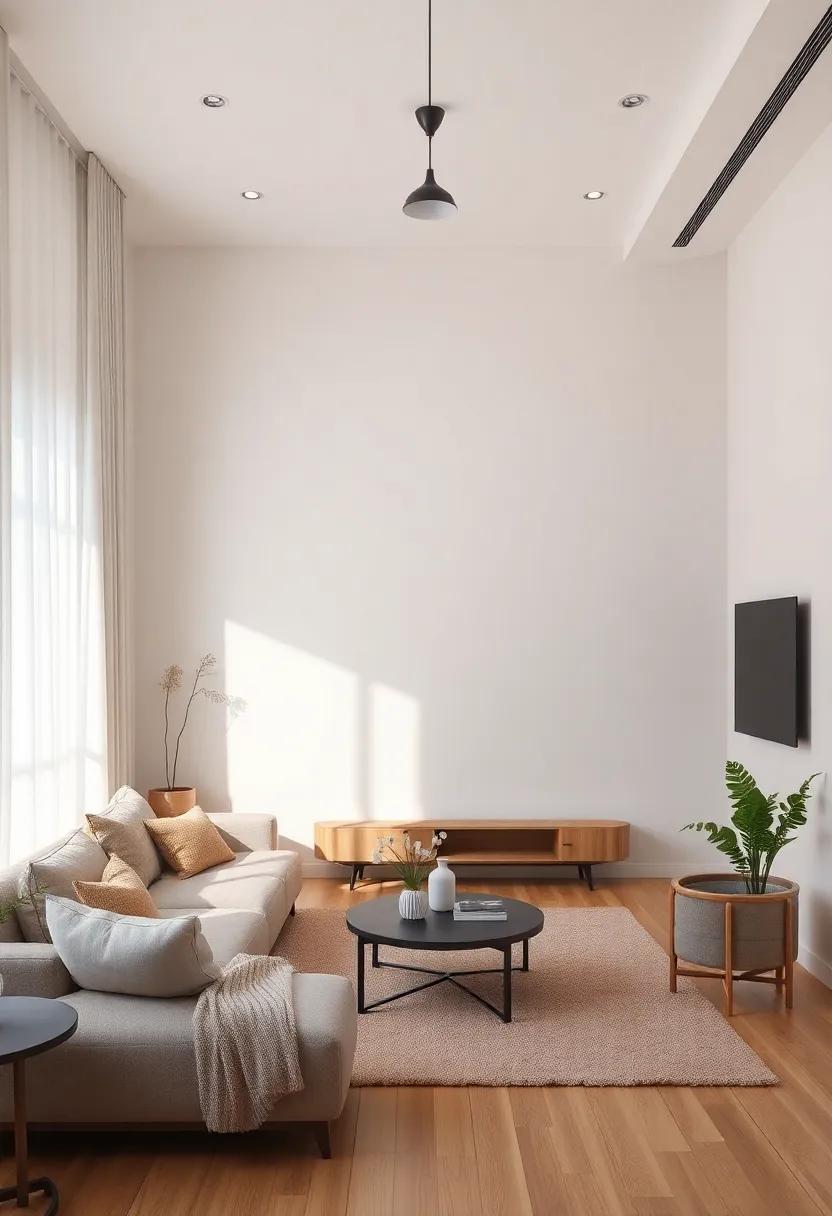
In a small living room, where space is often at a premium, its crucial to blend softer elements that bring warmth and invite comfort alongside the unforgiving lines of hard surfaces. Incorporate fabrics such as cotton, linen, or velvet through throw pillows or a cozy rug. These materials can soften the starkness of metal furniture or wooden flooring. Additionally, consider using organic shapes in your furniture and decor to counterbalance sharp angles and rigid lines. Round coffee tables or curvilinear chairs not only promote easy traffic flow but also provide a more approachable aesthetic.
Another effective strategy is to introduce layers of texture to create a harmonious feel. Utilizing a combination of tactile elements can ensure the space feels inviting rather than cold. Aim for a mix of texture variations, such as:
- Textured wall treatments like a subtle wallpaper or an accent wall with wood paneling
- Soft textiles like draped curtains that gently frame windows
- Natural elements such as potted plants, which add life and color while contrasting hard materials
Creating a balance through these elements allows the small living room to feel balanced and inviting, maximizing the use of space without compromising on style. For more inspiration on achieving this aesthetic, explore resources on [Apartment Therapy](https://www.apartmenttherapy.com).
The power of white Space in Creating Calm Atmospheres
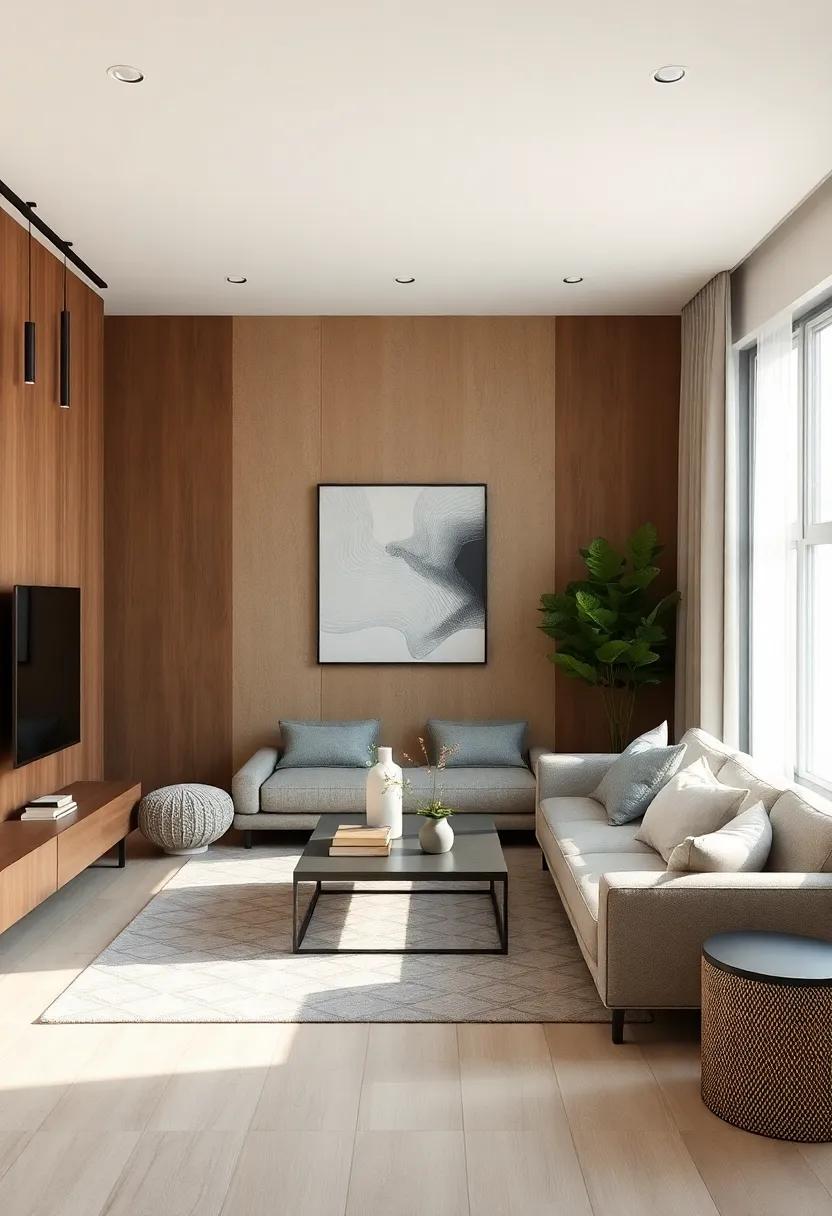
Incorporating white space into your small living room design can transform the space into a serene retreat. This essential element not only allows for breathing room but also emphasizes the details that matter, such as carefully chosen furniture or art pieces.Rather of cluttering the space with excess decor, consider a few key strategies to harness the effectiveness of white space:
- declutter: Begin by removing unnecessary items that crowd the room. Aim for a few well-placed decor pieces.
- Use Neutral Colors: A light color palette can create an airy feel and enhance the presence of white space.
- Focus on Focal Points: Highlight select elements of your design, like a statement chair or artwork, against an uncluttered background.
Alongside white space, the textures you choose contribute significantly to the calm atmosphere. Soft fabrics and natural materials can evoke a sense of tranquility, working harmoniously with the minimalist aesthetic.here are some tips for selecting textures that fit your vision:
- Natural Fibers: Incorporating cotton,linen,or wool can bring warmth while maintaining simplicity.
- Glass Accents: Introduce glass elements to reflect light and add an elegant touch without overwhelming the senses.
- Layered textures: Mix various materials, such as a sleek leather sofa with a cozy knit throw, to add depth without increasing visual clutter.
For more inspiration on minimalist design, consider visiting Apartment Therapy for creative ideas and resources.
Celebrating Asymmetry in a Balanced Minimalist Environment
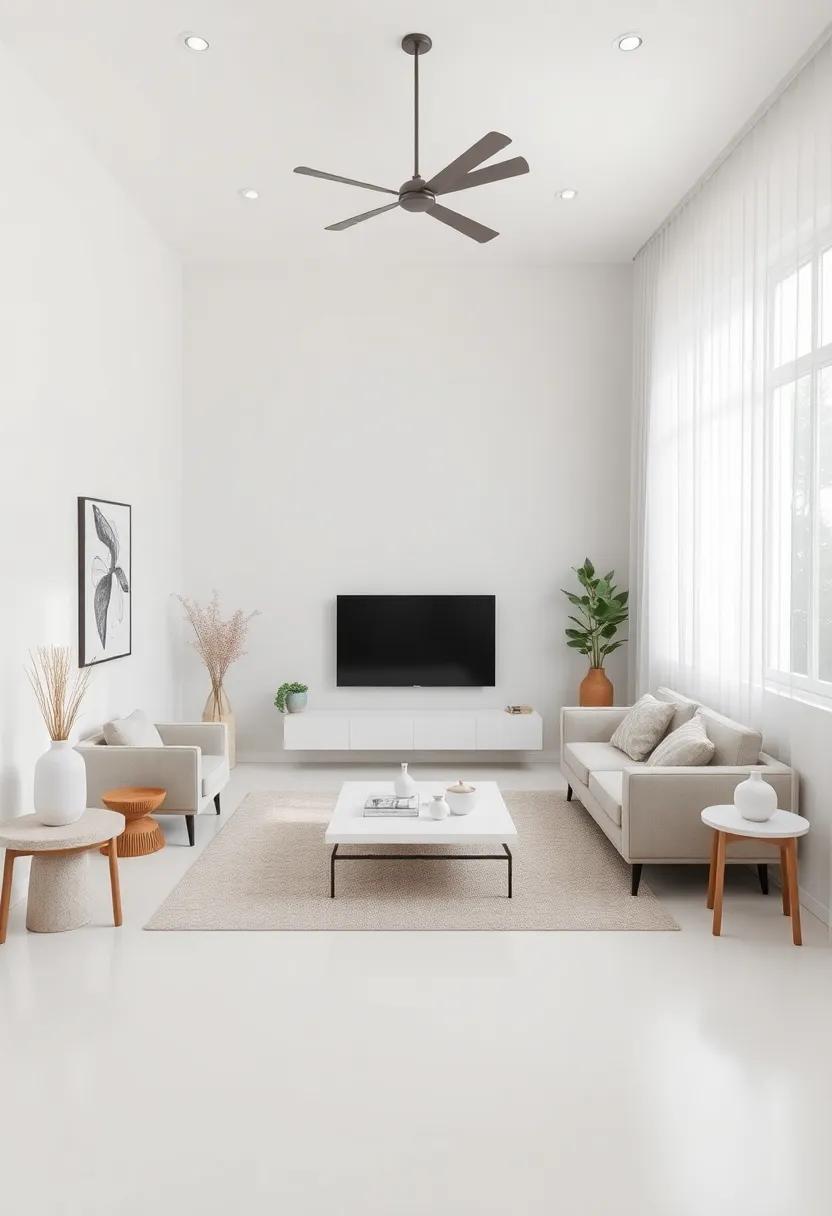
Asymmetry can be a powerful design choice in a minimalist setting, allowing the space to breathe while infusing a touch of dynamism. By consciously arranging elements in an uneven but cohesive manner, you can create visual interest without overwhelming the senses. Consider pairing a sleek sofa with an off-center coffee table to achieve a relaxed yet contemporary vibe. This intentional imbalance not only challenges customary perceptions of symmetry but also reflects the organic nature of everyday life. Use different heights in accessories, such as a tall floor lamp alongside a low-profile plant, to maintain a captivating flow throughout the room.
To enhance the beauty of asymmetry in your small living room, focus on texture and color. Incorporate a mix of materials like woven fabrics, wood accents, and ceramic finishes to create layers without adding clutter.A carefully curated display shelf can showcase art or books in varying sizes and orientations, making the wall a striking focal point. Consider using a simple color palette with occasional pops of color to highlight your core design elements. This strategic combination of diverse textures and colors can draw attention and provide balance, fostering an inviting yet stylish atmosphere. For more inspiring ideas, visit Dezeen.
Exploring Sustainable Materials for Conscious Design Choices
In the pursuit of a more sustainable future, the choice of materials for design plays a pivotal role in crafting environments that are both conscious and gorgeous. When selecting components for a small living room, consider utilizing eco-friendly textiles and reclaimed materials. These options not only minimize the ecological footprint but also contribute to a unique aesthetic that tells a story. Some great materials to explore include:
- bamboo: A fast-growing grass that can be used for flooring and furniture.
- Organic Cotton: Perfect for upholstery and throws, free from harmful chemicals.
- Recycled Wood: Adds warmth and character while promoting resource conservation.
- hemp: A durable fabric alternative for rugs and cushions.
along with material selection, the design process can incorporate natural finishes and minimalist textures that enhance the overall ambiance of the space. Consider opting for a calming palette of earthy tones that harmonize with these materials, creating a cohesive environment that feels open and inviting. To better visualize how to arrange your minimalist small living room, here’s a simple layout suggestion:
| Furniture Item | Optimal Placement |
|---|---|
| Sofa | Against the longest wall |
| Coffee Table | Centered in front of the sofa |
| accent Chair | Diagonal from the sofa |
| Shelf | Near a window for maximum light |
By thoughtfully selecting materials and employing strategic layouts, you can create an inviting small living room that resonates with simplicity and style. For more inspiration on sustainable design practices, visit Architectural Digest.
Elevating Small Rooms with Thoughtful Window Treatments
When it comes to small rooms, the right window treatments can transform the space while maintaining the essence of minimalist design. Opt for lightweight fabrics that allow natural light to flood the room, enhancing the perception of openness. Sheer curtains in soft colors can create an airy feel, while wooden blinds offer a modern touch without overwhelming the decor. Consider incorporating floor-to-ceiling drapes to draw the eye upward, giving the illusion of higher ceilings and more space. Remember to stick with monochromatic palettes or subtle patterns to keep the overall aesthetic simple yet elegant.
Another savvy approach is to utilize multi-functional window treatments.Look for options that combine sheer and blackout materials,allowing you to adjust light levels based on the time of day while maintaining a cohesive look. Avoid bulky curtain rods; instead,choose simple track systems that blend seamlessly with the wall. Additionally, placing mirrors opposite windows can reflect light and create the illusion of depth, making your small room feel more expansive. For more inspiration on creating the illusion of space with design, visit thespruce.com for expert tips and ideas.
Choosing Minimalist Artwork that Complements the Overall Aesthetic
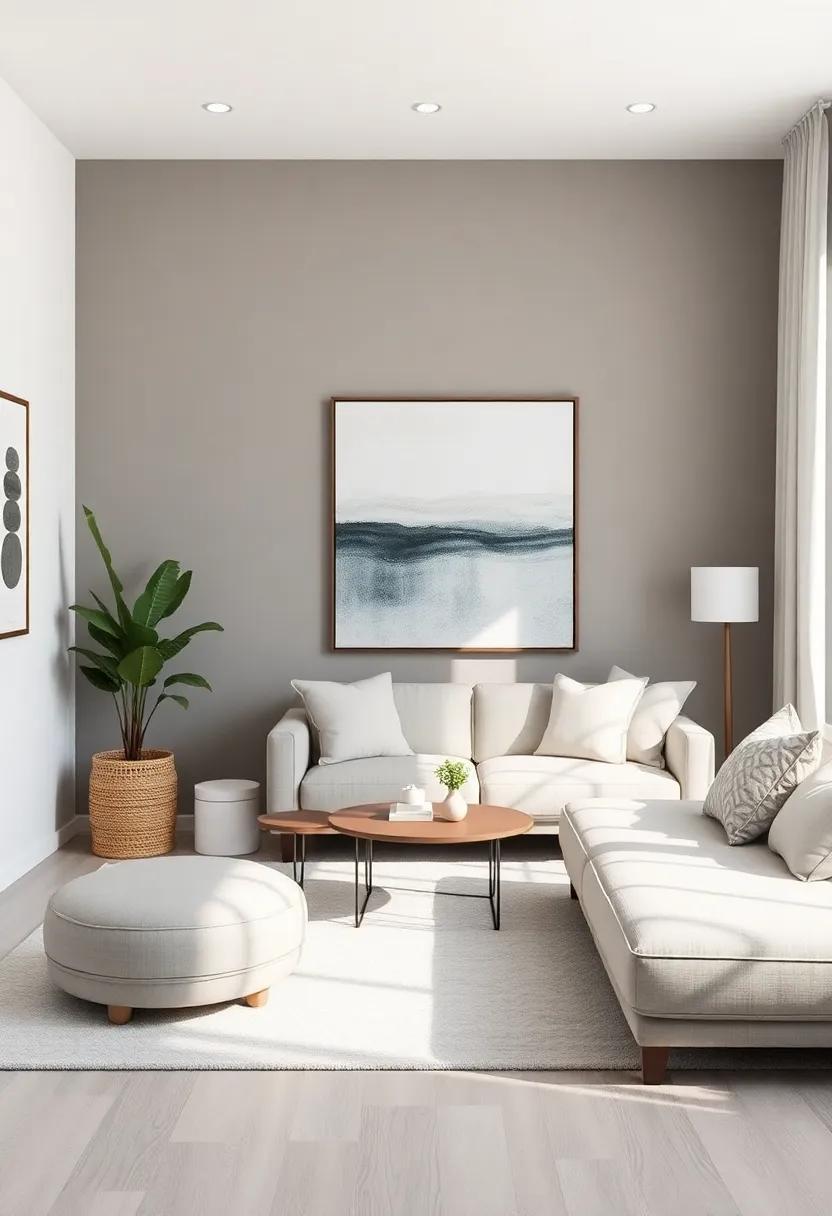
When selecting artwork for a minimalist space, it’s crucial to examine how each piece aligns with the overall aesthetics of the room.Look for artworks with clean lines and a limited color palette, as these qualities naturally complement a minimalist design.You might consider pieces that feature geometric shapes or abstract forms, which merge seamlessly with simple textures, enhancing the spacious feel of your small living room. To help focus your choices, try creating a mood board that captures your desired vibes, ensuring each artwork resonates with the space.
Incorporate artworks that serve as conversation starters without overwhelming your environment.Choose large focal pieces or a collection of smaller works that work well together. Items with a unified theme or color scheme can create a cohesive look.Here are a few tips for selecting artwork:
- Consider pieces that highlight natural elements, like landscapes or botanical prints.
- Opt for monochromatic works that reflect hues found in textiles or furniture.
- Think about framing; minimal frames can elevate your artwork without distracting from its essence.
To further enhance your decor, consider how different sizes and placements affect visual impact.For a well-balanced appearance, you may want to mix and match dimensions, employing a grid layout or asymmetrical arrangements to keep the eye moving throughout the space. A curated selection can bring depth and interest to your minimalist environment.
For additional inspiration on choosing the right artwork,you might find Artsy helpful.
Creating a Serene Atmosphere through Mindful Arrangement
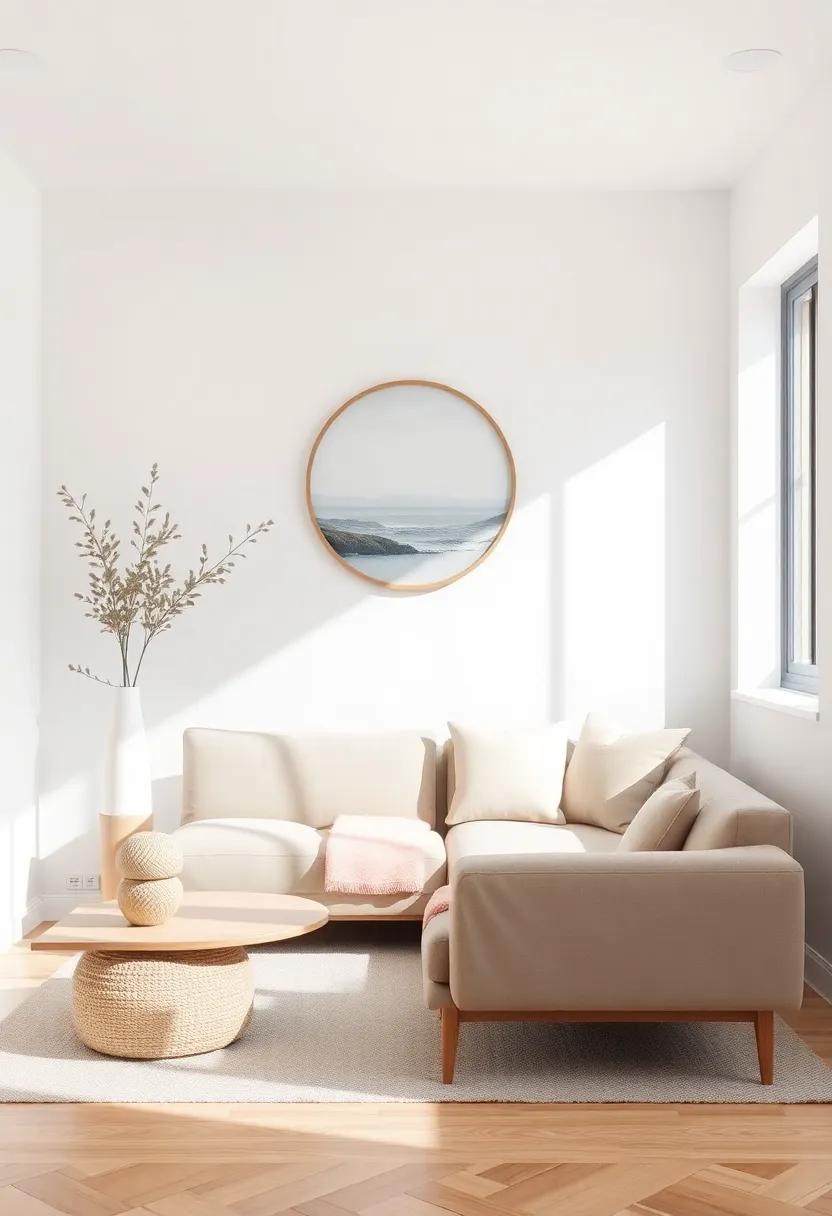
To cultivate a tranquil environment in your small living room, consider the principle of balance in your interior design. A harmonious arrangement not only enhances the aesthetic but also promotes a sense of calm. Start by ensuring your furnishings are placed thoughtfully; as an example, try to group your seating a little towards the center rather than lining the walls. this layout encourages conversation and connection while keeping the space open. Additionally, you might want to utilize furniture with clean lines and simple shapes to avoid overwhelming the eye, making the room feel more spacious and airy.
Another crucial aspect is the use of textures that further enhance serenity. Opt for fabrics that are soft and inviting; cotton, linen, and wool can add warmth without cluttering the visual space. Integrate a mix of textures through throw pillows, soft rugs, and perhaps a light throw blanket draped over a chair. Moreover, incorporating natural elements such as wood or plants can ground the room and introduce a refreshing connection to nature. For a deeper understanding of creating soothing spaces, explore resources from Apartment Therapy for tips and inspiration tailored to small, minimalist living areas.
In Summary
embracing simplicity in your small living room can transform the space into a serene oasis that reflects both your style and your lifestyle. By thoughtfully selecting minimalist textures, you not only enhance the visual appeal but also cultivate an environment that promotes calm and clarity. remember, the essence of minimalist design lies in the mantra of less is more—each piece should earn its place and purpose. as you embark on your design journey, allow the elegance of simplicity to guide your choices, creating a harmonious haven that invites relaxation and inspires creativity. Ultimately,a well-curated space is not just about aesthetics; it’s about crafting a backdrop for your life,where each moment feels a little more special,and every corner tells a story. So take a deep breath, embrace the beauty of simplicity, and let your small living room shine with a quiet elegance all its own.
